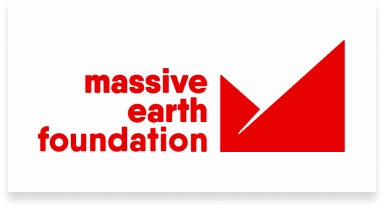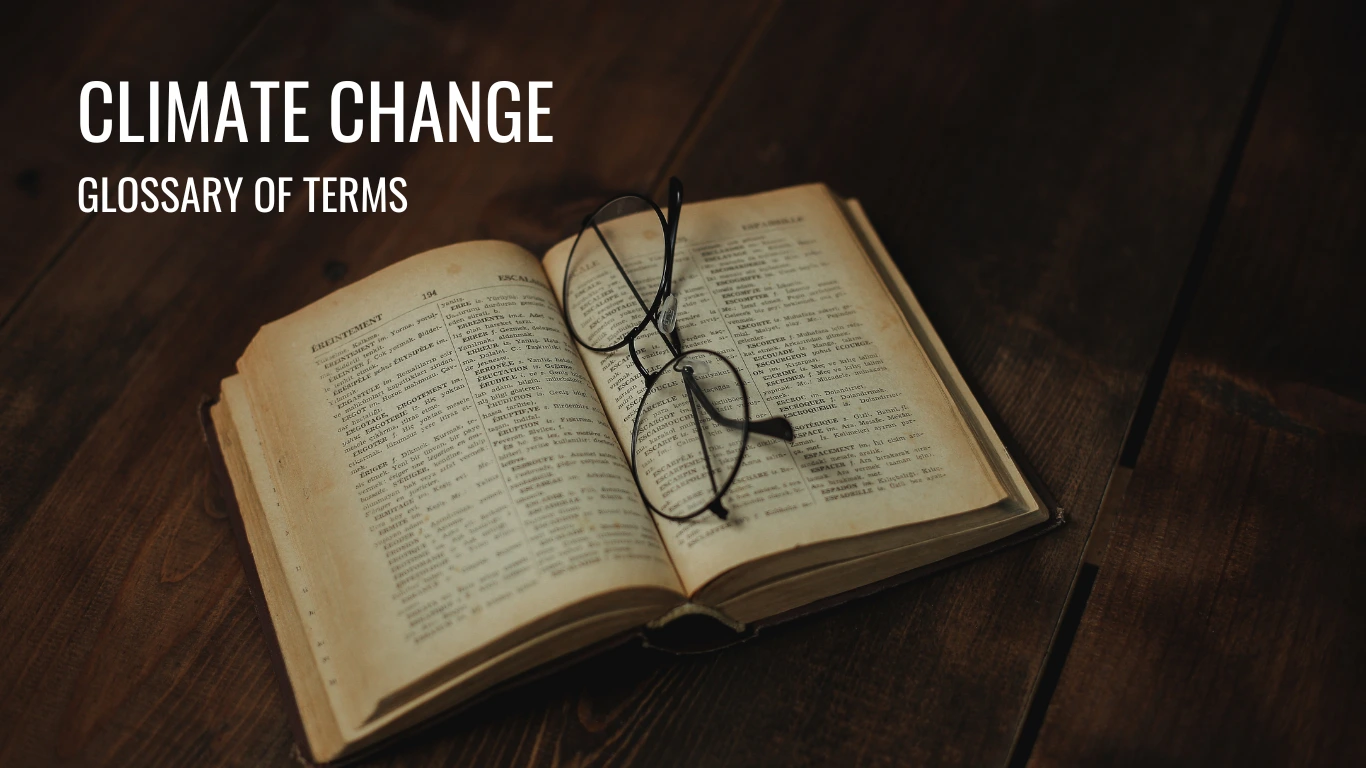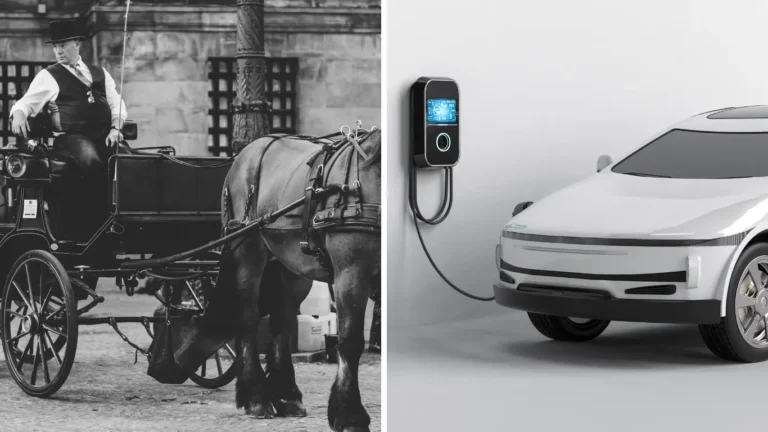Climate change is a global problem that evolves continuously as fresh data and new insights emerge from all over the world. With new ideas, concepts, and novel terms being added daily, it can be challenging to learn about climate change in an organized manner. To help navigate this complexity, here’s a glossary of some common and simple terms used frequently in discussions about climate-related issues.
GLOSSARY
1.5 Degree Celsius: The global temperature rise limit agreed upon in the Paris Agreement to avoid the worst impacts of climate change.
51 Gigatons: The approximate amount of global greenhouse gas emissions, measured in gigatons of CO2 equivalent, produced annually.
Acid Rain: Rain that contains higher levels of acidic chemicals, usually caused by air pollution, which can harm plants, animals, and buildings.
Adaptation: The process of adjusting to current or expected climate changes to reduce harm or exploit beneficial opportunities.
Afforestation: Planting trees on land that was not previously forested to absorb carbon dioxide from the atmosphere.
Albedo Effect: The ability of a surface to reflect sunlight. Surfaces like ice and snow have a high albedo, reflecting more sunlight and helping to keep the Earth cool.
Anthropogenic: Caused or influenced by human activities, often used to describe greenhouse gas emissions or climate change.
Atmosphere: The layer of gases surrounding Earth, made up of nitrogen, oxygen, and other trace gases, including greenhouse gases.
Biodiversity: The variety of plant, animal, and microorganism species in an ecosystem, which is crucial for a healthy environment.
Biofuel: Fuel derived from living organisms, such as plants, which can be used as an alternative to fossil fuels.
Carbon Capture & Storage: A technology that captures carbon dioxide emissions from sources like power plants and stores it underground to prevent it from entering the atmosphere.
Carbon Cycle: The natural process by which carbon moves through the Earth’s atmosphere, oceans, soil, and living organisms.
Carbon Dioxide (CO2): A greenhouse gas emitted from natural processes and human activities like burning fossil fuels, which contributes to global warming.
Carbon Dioxide Removal (CDR): Techniques or technologies used to remove CO2 from the atmosphere to reduce its concentration.
Carbon Footprint: The total amount of greenhouse gases emitted directly or indirectly by a person, organization, or product.
Carbon Neutral: Achieving a balance between emitting carbon dioxide and absorbing an equivalent amount from the atmosphere.
Carbon Offset: A reduction in greenhouse gas emissions to compensate for emissions produced elsewhere, often through projects like tree planting or renewable energy.
Carbon Sequestration: The process of capturing and storing carbon dioxide from the atmosphere, often in forests, soil, or underground.
Carbon Tax: A tax imposed on the carbon content of fossil fuels, aimed at reducing carbon dioxide emissions.
Carbon Trading: A market-based approach to controlling pollution by providing economic incentives for reducing the emissions of pollutants.
CBDR – Common But Differentiated Responsibilities: A principle in international environmental law recognizing that all countries are responsible for addressing environmental destruction, but not equally.
CDM – Clean Development Mechanism: A United Nations program that allows industrialized countries to invest in projects that reduce emissions in developing countries as a way to meet their emission targets.
CDR – Carbon Dioxide Removal: Processes that aim to remove CO2 from the atmosphere, either naturally or through technology.
Circular Economy: An economic model focused on minimizing waste and making the most of resources by reusing and recycling.
Clean Energy: Energy that comes from sources that do not pollute the atmosphere when used, such as wind, solar, and hydropower.
Climate: The long-term pattern of weather conditions in a particular area, including temperature, precipitation, and wind.
Climate Action: Efforts to reduce greenhouse gas emissions and enhance resilience to climate change.
Climate Change: Long-term changes in temperature, precipitation, wind patterns, and other elements of Earth’s climate system.
Climate Finance: Funding aimed at helping countries mitigate and adapt to climate change impacts.
Climate Investment Funds (CIF): Multilateral funds established to support climate action and the shift to a low-carbon economy.
Climate Risk Early Warning System (CREWS): A global initiative to increase early warning systems for extreme weather and climate events.
Climate Technology: Technologies that help reduce greenhouse gas emissions and increase resilience to climate impacts.
Climatology: The scientific study of climate, including its patterns, causes, and effects.
Coal: A fossil fuel that, when burned, releases a large amount of carbon dioxide and contributes to global warming.
CO2 Equivalent: A standard unit for measuring carbon footprints, expressing the impact of different greenhouse gases in terms of the amount of CO2 that would have the same warming effect.
Conference of Parties (COP): Annual meetings of countries that are part of the UNFCCC to negotiate and review international climate change agreements.
COP21: The 21st Conference of the Parties held in Paris in 2015, where the Paris Agreement was adopted.
Coral Bleaching: The whitening of corals due to stress, often caused by increased water temperatures, which can lead to coral death.
CSR – Corporate Social Responsibility: A business model in which companies incorporate social and environmental concerns into their operations.
Deforestation: The clearing or removal of forests, usually for agriculture or urban development, which contributes to increased carbon dioxide levels.
Desertification: The process by which fertile land becomes desert, usually as a result of drought, deforestation, or improper agriculture.
Earth’s Average Temperature: The global average temperature, which has been rising due to increased greenhouse gas emissions.
Eco-friendly: Products or practices that are not harmful to the environment.
Ecosystem: A community of living organisms and their physical environment, interacting as a system.
Emissions: The release of gases, such as carbon dioxide and methane, into the atmosphere, which contribute to global warming.
Energy: The ability to do work, often derived from sources like fossil fuels, renewable resources, or nuclear power.
Environmental Impact: The effect of human activities on the natural environment, including air, water, and soil quality.
Extreme Weather: Unusually severe or unseasonal weather events, such as hurricanes, heatwaves, or heavy rainfall, often linked to climate change.
Feedback Loop: A process where the output of a system amplifies (positive feedback) or diminishes (negative feedback) the system’s activity, such as ice melting leading to more warming.
Fossil Fuels: Non-renewable energy sources such as coal, oil, and natural gas, formed from ancient organic matter.
GCF – Green Climate Fund: A fund established by the UNFCCC to help developing countries limit or reduce their greenhouse gas emissions and adapt to climate change.
Geoengineering: The deliberate modification of Earth’s environment to combat climate change, such as by increasing the reflectivity of the atmosphere.
GHG Emissions: Emissions of greenhouse gases, which trap heat in the atmosphere and contribute to global warming.
Glacier: A large, slow-moving mass of ice formed from compacted snow, which can shrink due to global warming.
Global Warming: The gradual increase in Earth’s average surface temperature due to the buildup of greenhouse gases in the atmosphere.
Global Warming Potential (GWP): A measure of how much heat a greenhouse gas traps in the atmosphere over a specific time compared to CO2.
Greenhouse Effect: The warming of Earth’s surface caused by the trapping of heat by greenhouse gases in the atmosphere.
Greenhouse Gases (GHGs): Gases like carbon dioxide, methane, and nitrous oxide that trap heat in the Earth’s atmosphere, causing global warming.
Green Premium: The additional cost of choosing a cleaner energy source over a more polluting one.
Greenwashing: Misleading claims by companies that their products or practices are environmentally friendly when they are not.
Heat Island Effect: Urban areas becoming significantly warmer than rural areas due to human activities and buildings trapping heat.
Hydrosphere: All the water on Earth’s surface, including oceans, lakes, rivers, and glaciers.
Ice Age: A period in Earth’s history when ice sheets covered large parts of the planet, typically resulting in cooler global temperatures.
Ice Cap: A large area of ice that covers the land, typically found at the Earth’s poles.
Industrial Revolution: The period of rapid industrialization that began in the late 18th century, which significantly increased greenhouse gas emissions.
Intergovernmental Panel on Climate Change (IPCC): A global body of scientists that assesses climate change research and provides recommendations for policy.
IPCC – Intergovernmental Panel on Climate Change: An international body that assesses the science related to climate change.
Keeling Curve: A graph showing the increase in atmospheric carbon dioxide concentrations over time, based on continuous measurements since 1958.
Kyoto Protocol: An international agreement aimed at reducing greenhouse gas emissions to combat global warming.
Methane: A potent greenhouse gas produced by natural processes like decay and human activities such as livestock farming.
Microclimate: The climate of a small, specific area that may differ from the surrounding general climate.
Mitigation: Actions taken to reduce or prevent the emission of greenhouse gases, aimed at slowing down global warming.
NDC – Nationally Determined Contributions: Climate action plans submitted by countries under the Paris Agreement outlining efforts to reduce national emissions.
Net-Zero: Achieving a balance between the greenhouse gases emitted and those removed from the atmosphere.
Ocean Acidification: The process by which the oceans absorb excess carbon dioxide, making the water more acidic.
Ozone Layer: A layer in Earth’s stratosphere that absorbs most of the sun’s ultraviolet radiation, protecting living organisms.
Paris Agreement: An international treaty to reduce global warming and limit temperature increase to below 2°C above pre-industrial levels.
Permafrost: Ground that remains frozen for at least two consecutive years, which can release greenhouse gases when it thaws.
Pollution: The introduction of harmful substances or products into the environment, affecting air, water, and soil.
PSR – Precautionary Principle: A principle in environmental policy where preventive action is taken to avoid harm even if some cause-and-effect relationships are not fully established.
Radiative Forcing: The change in energy balance in the Earth’s atmosphere due to factors like greenhouse gases and solar radiation.
Reforestation: Planting trees in an area where the forest was previously cut down or destroyed.
Renewable Energy: Energy from sources that are replenished naturally, such as wind, solar, and hydro.
Sea Level Rise: The increase in the level of the world’s oceans due to melting ice caps and the expansion of seawater as it warms.
SDG – Sustainable Development Goals: A collection of 17 global goals set by the United Nations to promote prosperity while protecting the planet.
Sixth Assessment Report: The latest major report from the IPCC, assessing the current state of climate science.
Smog: Fog combined with smoke or other air pollutants, commonly found in urban areas.
Sustainability: The practice of using natural resources in a way that meets current needs without compromising the ability of future generations to meet theirs.
Sustainable Development: Development that meets present needs without compromising the ability of future generations to meet their own needs.
Thermal Expansion: The increase in volume of water as it warms, contributing to sea-level rise.
Tipping Point: A critical threshold at which a small change can lead to dramatic and irreversible effects on the environment.
UNEP – United Nations Environment Programme: A global organization focused on environmental issues.
UNFCCC – United Nations Framework Convention on Climate Change: An international treaty aimed at addressing climate change and stabilizing greenhouse gas concentrations.
Weather: The short-term state of the atmosphere at a particular place and time, including temperature, humidity, and precipitation.
WMO – World Meteorological Organization: A specialized agency of the United Nations that provides weather, climate, and water-related information.






